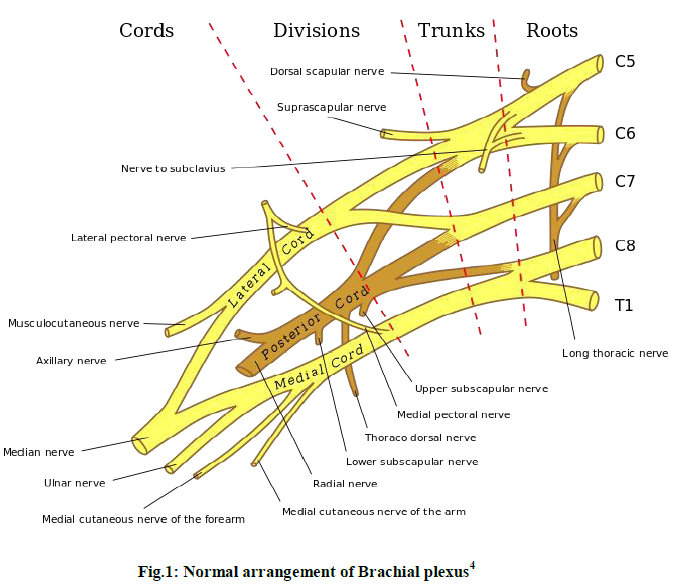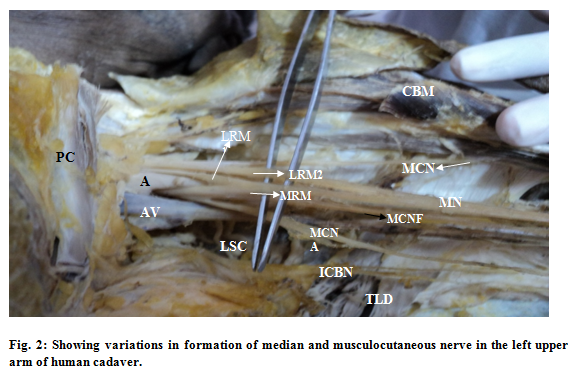IJCRR - 5(23), December, 2013
Pages: 55-58
Date of Publication: 16-Dec-2013
Print Article
Download XML Download PDF
FORMATION OF MEDIAN NERVE BY THREE ROOTS AND ORIGIN OF MUSCULOCUTANEOUS NERVE FROM LATERAL ROOT OF MEDIAN NERVE
Author: Sumi Ghorai
Category: Healthcare
Abstract:The present case report describes the unusual formation of median nerve by the fusion of three roots, two from the lateral and one from the medial cord of the brachial plexus in left upper extremity. One root after arising from lateral cord joined with medial root of median nerve after crossing in front of axillary artery high up in the axilla and another root joined the medial root at normal site. Normally musculocutaneous nerve originates from lateral cord of brachial plexus but in this case it took its origin from the lateral root of median nerve. I illustrate this as a unique case of \"Formation of Median Nerve by three Roots and Origin of Musculocutaneous Nerve From Lateral Root of Median Nerve.\"
Keywords: Median nerve, musculocutaneous nerve, variation.
Full Text:
INTRODUCTION
The median nerve, branch of the brachial plexus, commonly shows variation in its formation and distribution.1 The median nerve (C5-T1) is formed by union of medial and lateral roots, anterior or anterolateral to the third part of axillary artery2. Anterior division of lower trunk (C8,T1) continues to form the medial cord which give rise to medial root. The lateral root originates from the lateral cord coming from anterior divisions of upper and middle trunks(C5,C6,C7).3 After giving the first branch (Lateral pectoral nerve), the lateral cord divides into musculocutaneous nerve and lateral root of median nerve (Fig. 1).4 The musculocutaneous nerve shows frequent variations in connection to the median nerve. It may run behind the coracobrachialis muscle or adhere for some distance to the median nerve and pass behind the biceps brachii muscle or some fibers of the median nerve may run in the musculocutaneous nerve and less frequently the median nerve sends a branch to the musculocutaneous nerve.5,6 The present case report deals with a rare variation of origin of musculocutaneous nerve from lateral root of median nerve and formation of median nerve by three roots. This is important to know the anatomical variations of the peripheral nerves in the upper limbs as these abnormal nerves could be injured during surgical procedures and also explain unusual clinical symptoms.
CASE REPORT
The present case was encountered during routine dissection of left upper limb of a male cadaver in the department of Anatomy, I.Q.City Medical College, Durgapur. An unusual branching pattern of brachial plexus in the formation of median nerve was detected and also a rare case of origin of musculocutaneous nerve was observed. Median nerve was formed by three roots; two of them came from lateral cord and one from medial cord. The first root from lateral cord joined the medial root high up in the axilla crossing infront of third part of axillary artery. The second one joined the medial root in the lower part of axilla antero-lateral to the artery and the first root was smaller.
Musculocutaneous nerve took its origin from the second root of lateral cord. Then it pierces the coracobrachialis muscle (Fig. 2).
DISCUSSION
It is interesting as every arm can show different variants in the formation and course of the median nerve. Sontakke BR. et al.7 described a case where median nerve was formed by three roots; two of them came from lateral cord and one from medial cord. The first root that arose from lateral cord joined the medial root in the axilla but the second one joined with the medial root in the arm to form the median nerve, however Pais D. et al.8 reported that median nerve were formed by three roots. Two roots came from lateral cord and one from medial cord. Both the roots coming from lateral cord joined with medial root in the axilla. The first root of lateral cord was a smaller branch arising from its terminal portion. In the present study it has been observed that in left upper limb the third root (additional root) arose from lateral cord of brachial plexus and the musculocuteneous nerve took its origin from this root.
Several variations of median nerve was reported in the literature, include abnormal communications with other nerves such as musculocutaneous and ulnar nerves9. In the study of Choi D et al10, connections of the median and musculocutaneous nerves were observed in 26.4% of 138 arms. The nerves were either fused, or there were one or two communicating branches from the musculocutaneous nerve to the median nerve. Loukas M et al11 found the communicating branch between the median and musculocutaneous nerves in 63.5% of cadavers, most of these connections located proximal to the point of entry of the musculocutaneous nerve into the coracobrachialis muscle. There was no such study regarding origin of musculocutaneous nerve from median nerve, as in this case the musculocutaneous nerve took its origin from the second larger lateral root of median nerve.
CONCLUSION
The connections and distribution patterns of both nerves are important in surgical approaches to the arm and implications of clinical findings. Surgeons and clinicians should know the presence of variations during surgical procedures and clinical investigations of the arm.
ACKNOWLEDGEMENT
The author of this case report gratefully acknowledges the inspiration and help received from the scholars whose articles have been cited in the reference section. The author pays gratitude to authors/editors/publishers of all those articles/journals/books from where the reviews and literatures for the discussion have been collected.


PCM: Pectoralis Minor Muscle, AA: Axillary Artery, AV: Axillary Vein CBM: Coracobrachialis Muscle, TLDM: Tendon Of Latissimus Dorsi Muscle, LRM1: Lateal Root Of Median Nerve 1, LRMN2: Lateral Root Of Median Nerve 2, MRM: Medial Root Of Median Nerve, MN: Median Nerve, MCN: Musculocutaneous nerve ICBN: Intercostobrachial Nerve, MCNA: Medial Cutaneous Nerve Of Arm, MCNF: Medial Cutaneous Nerve Of Forearm, LSCN: Lower Subscapular Nerve.
References:
- Saeed M, Rufai AA. Median and Musculocutaneous nerves: Variant formation and distribution. Clinical Anatomy 2003; 16:453-57.
- Williams PL, Bannister LH, Berry MM, Collins P, Dyson M, Dussek JE, et al editors. Gray’s anatomy. 38th ed. Philadelphia: WB-Saunders;1995.
- April EW. Anatomy. Toronto: Harval Publishing Co; 1985.
- Brachial plexus. http://en.wikipedia.org/wiki/Brachial_plexus#Root. [Last accessed on 2013 Aug. 18]
- Standring S. Gray’s anatomy. The anatomical basis of clinical practice. 39th ed. London: Elsevier Churchill Livingstone; 2005.
- Moore KL, Dalley AF. Clinically oriented anatomy. 4th ed. Philadelphia: Lippincott Williams and Wilkins; 1999.
- Sontakke BR, Tarnekar AM, Waghmare JE, Ingole IV. An unusual case of an asymmetrical formation and distribution of median nerve. International Journal of Anatomical Variations, 2011, vol. 4, p. 57-60.
- Pais D, Casal D, Santos A, O’neill JG. A variation in the origin of median nerve associated with unusual origin of the deep brachial artery. Journal of morphological sciences 2010; vol. 27, p. 35-38.
- Chauhan R, Roy TS. Communication between the median and musculocutaneous nerve- A case report. Journal of anatomical society of India 2002; 51: 72-5.
- Choi D, Rodriguez NM, Vazquez T, Parkin I, Sanudo JR. Patterns of connections between the musculocutaneous and median nerves in the axilla and arm. Clin Anat 2002;15:11-7.
- Loukas M, Aqueelah H. Musculocutaneous and median nerve connections within, proximal and distal to the coracobrachialis muscle. Folia Morphol 2005; 64: 101-8.
|






 This work is licensed under a Creative Commons Attribution-NonCommercial 4.0 International License
This work is licensed under a Creative Commons Attribution-NonCommercial 4.0 International License